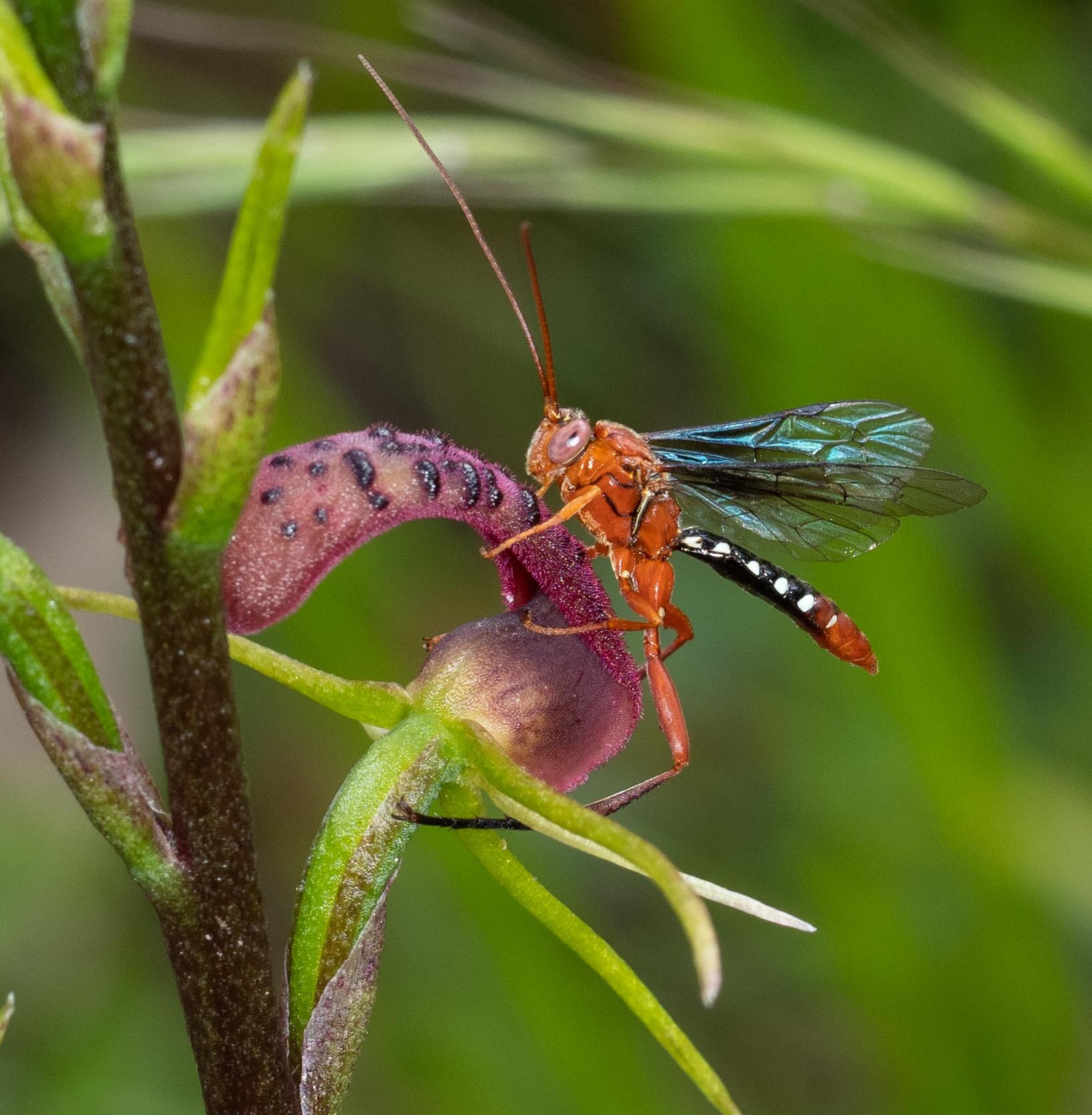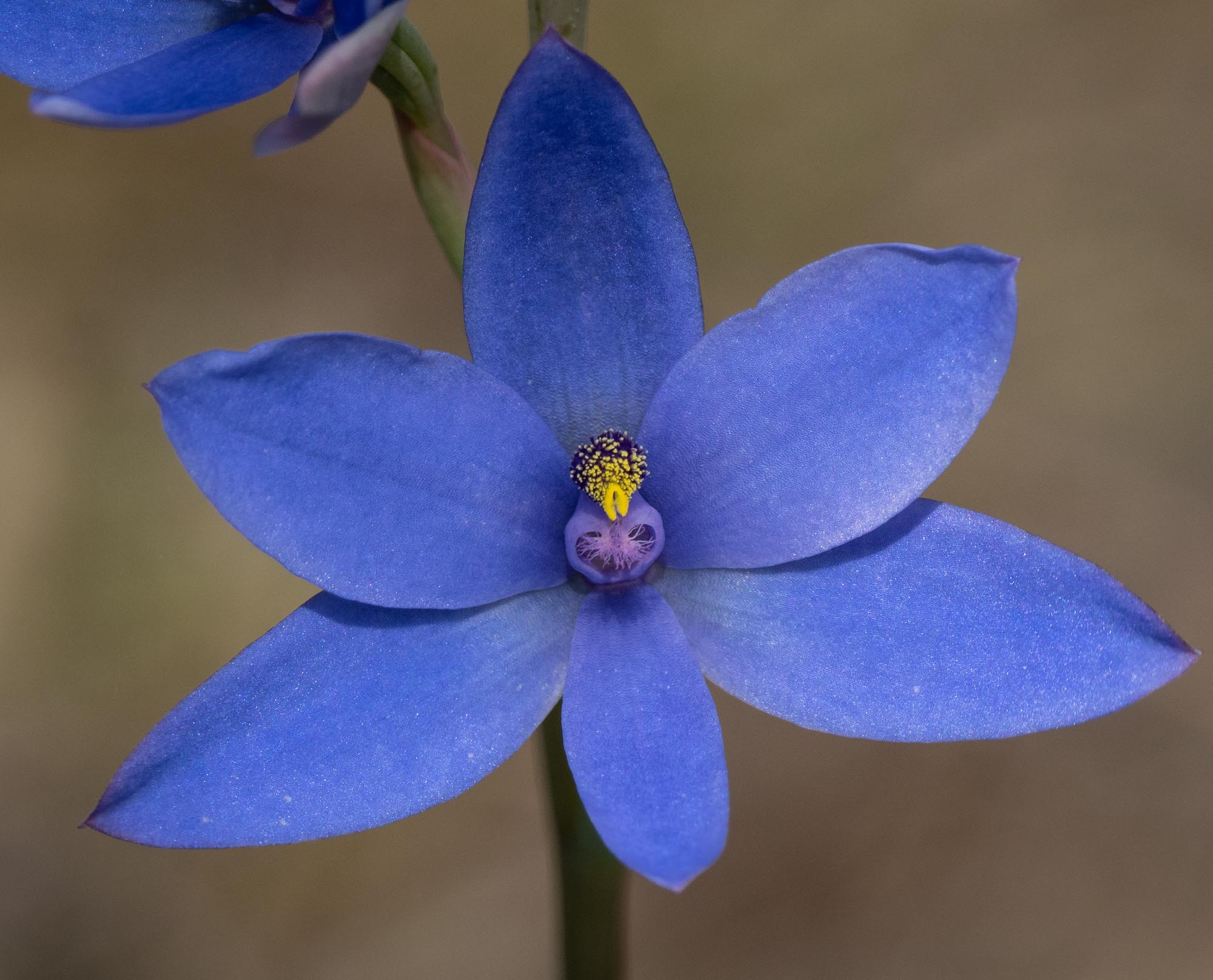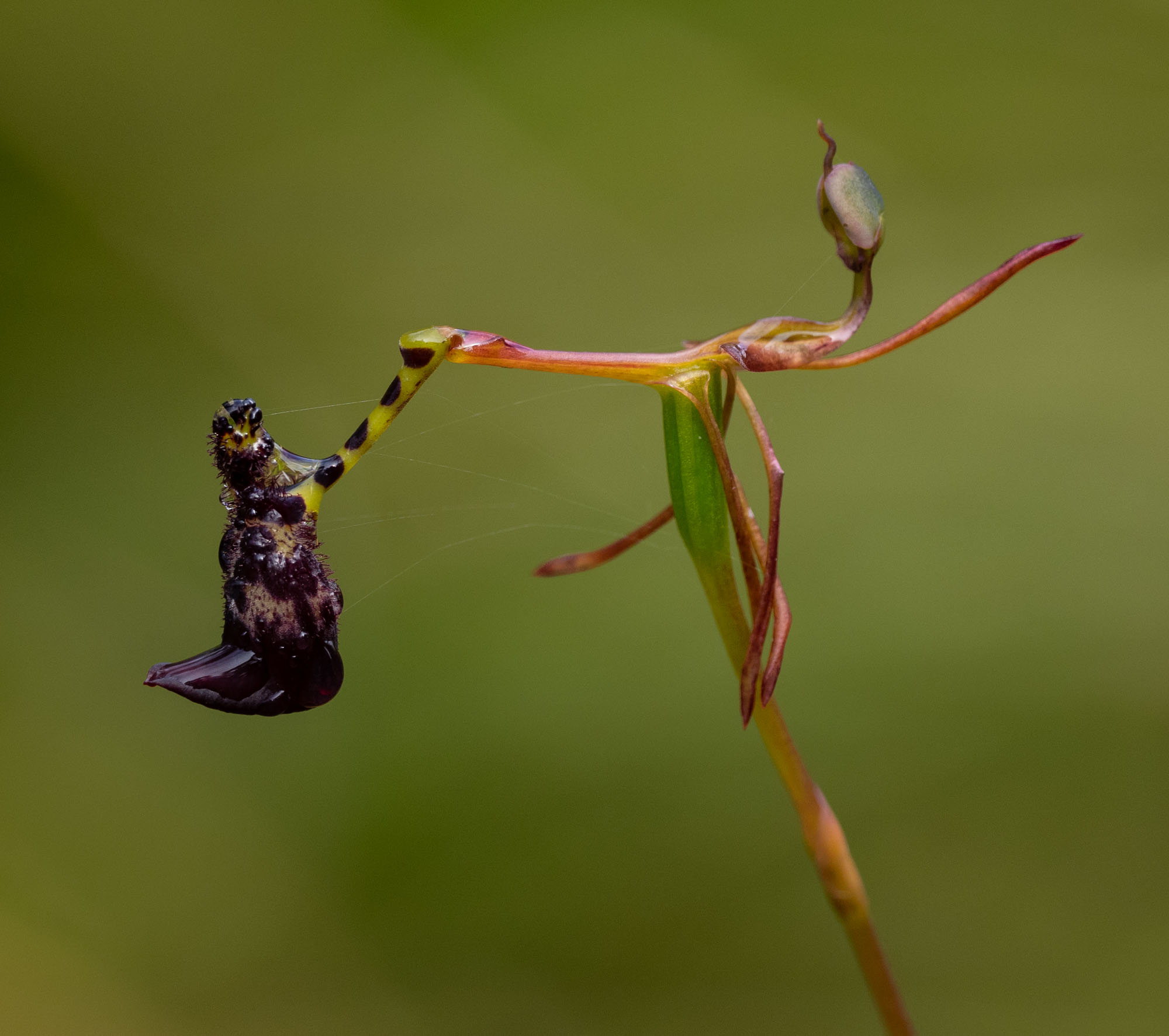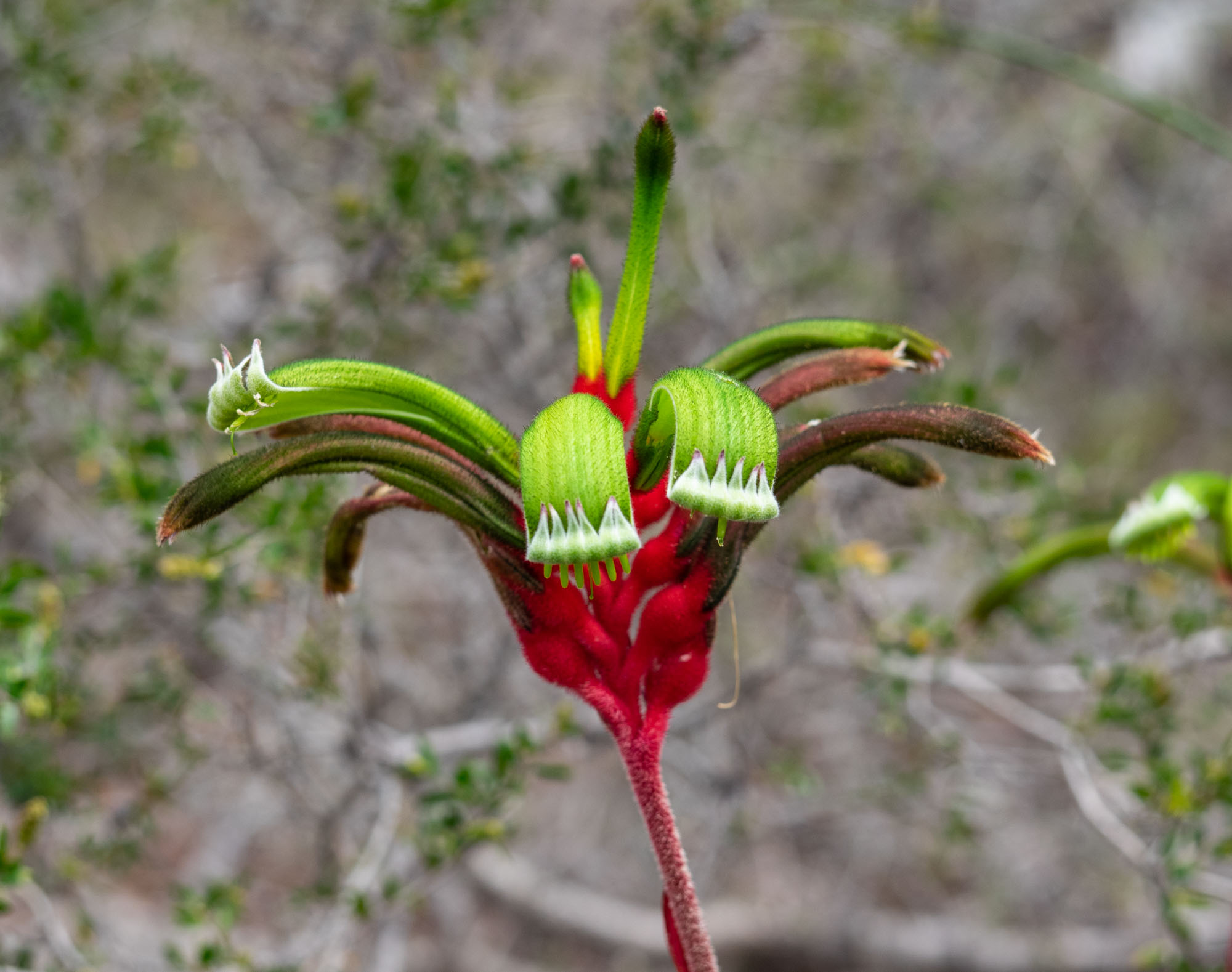First orchid out of the blocks
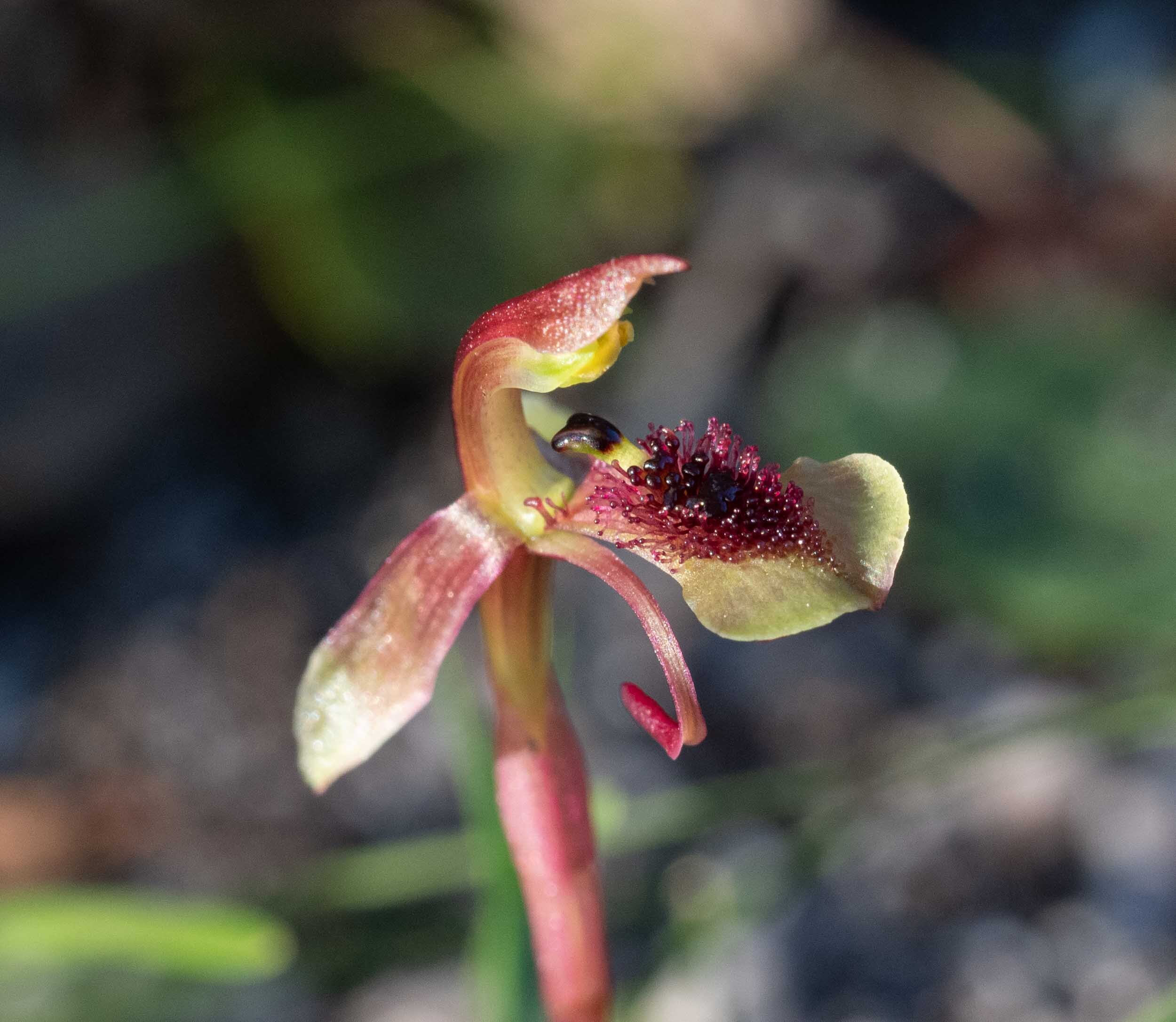
Sightings of native orchids are always special. But finding the first orchid to reappear in our forest in the wake of the January Border Fire was a particularly exciting experience. Especially as it turned out to be a new “home” species!
A fortuitous chain of events led to this discovery. It’s a bit of a convoluted story, so bear with me.
Fungi and flies
Autumn is of course the time when many fungi thrust their fruiting bodies out of the soil. Some of these are visited by insects. Let me give you two examples.
The Crinoline Stinkhorn is appropriately named, as it emits a decidedly fetid odour. (Its scientific name Phallus multicolour is also rather apt). A host of different fly species are attracted by the scent, fooled into thinking it emanates from animal faeces. I enjoyed photographing them as they wandered around the stinkhorns.
The second fly-attracting fungus, Sulphur Caps (Hypholoma fasciculare), has a more mundane appearance and lacks the malodorous scent. But it is nonetheless an attractive target for a particular group of flies - the Fungus Gnats (Mycetophila sp). A cloud of these flies hovered around the fungus as I photographed it and many landed on the cap, stem and gills. The flies lay their eggs on the gills, which provide a nutritious food source for their developing larvae.
From fungus fly to orchid
In the course of this fly/fungi photography frenzy I serendipitously captured this shot of a fungus gnat in mid flight.
On viewing my photo, Kerri remarked that the fly seemed to be carrying two orchid pollinia, the yellow blobs on its back. Orchids pack their pollen tightly into these compact parcels.
So we reasoned that somewhere near the spot where I photographed this creature, an orchid must be flowering.
The hunt was on!
It didn’t take long to discover the orchid in question. It was in precisely the same area where I photographed the fungus gnat the day before.
When I say orchid, I actually mean orchids. There are many plants - probably well over 100 - in an area of less than 15 sq.m. The orchid flowers are small - only about 6cm tall - and easy to overlook. But a close look reveals their beautiful, complex morphology.
The following images show some of the characteristic features of these plants.
So who is this orchid?
After searching through a couple of field guides we came up with three candidates, all in the genus Chiloglottis, Bird Orchids. I got in touch with David Jones, the renown Australian orchid expert, who confirmed the identity of our plant as Chiloglottis curviclavia, the Autumn Wasp Orchid.
David published the original description of this species in 2018 (ref.1). He has provided us with some valuable information about the species, which I’ve supplemented by further reading.
More cool facts about Bird Orchids
Our orchids are growing in sandy soil, in a sheltered, shady area surrounded by grasses and forbs. This is typical habitat for Chiloglottis species (Ref. 2).
Crowded conditions like this present a problem for the orchid - how to disperse your seeds when your flower is surrounded by much taller neighbours? The solution is quite ingenious. After pollination and before seed dispersal, the stem of the flower, the pedicel, thickens and grows to a length of up to 30cm (ref. 2). This places the seed head well above many of the surrounding plants.
Chiloglottis curviclava flowers more freely than normal after summer fires. This fits with the fact that we haven’t previously seen this orchid in the 9 years we’ve lived on the block. The opposite holds for other Chiloglottis species - their flowering is generally inhibited by summer bushfires (ref. 2).
All Chiloglottis species grow in clonal colonies. Tubers form at the end of stolonoid roots of a plant and these give rise to new plants (ref.2). So all of the orchids in our 15 sq.m patch are essentially one plant - all joined together and genetically identical.
Quite a few of our Chiloglottis curviclava are flowering, while many have not yet started. Bird orchids in general flower in late summer and autumn.
Bird Orchid pollination
This is an extraordinary story!
Chiloglottis species are pollinated by wasps, but not just any wasp. The job is done by wasps in the subfamily Thynninae of the family Tiphiidae. Female thynnine wasps generally lack wings. They attract males for copulation by releasing pheromones. Kerri shows nice images of the mating ritual of a pair of thynnine wasps in an earlier post.
Bird Orchids produce and release chemicals from their sepals and calli, which mimic the female wasp pheromones. Male wasps are fooled and are magnetically attracted to the orchid. This is where it gets really interesting.
The arrangement of calli on the labellum bears a strong resemblance to a female wasp with its head facing the base of the flower. I can’t see it myself but it clearly works for the male wasp. He lands on the labellum and grasps the decoy female. It’s called ‘sexual deceit’ in the trade.
As he probes the labellum and attempts to fly off with it (as he would do if it were a real female), he contacts the anthers and gets daubed with pollinia, the packets of pollen. Finally, he flies off unrequited to another orchid flower to make another mating attempt. This time he contacts the stigmata of the orchid during his struggles with the recalcitrant pseudofemale and transfers the pollinia to that flower. Pollination ensues!
What is even more amazing is that each Chiloglottis species in its natural range uses a unique wasp species for this task (ref.3). There are hundreds of thynnine wasp species - more than enough to go around for the 24 described Australian species of Chiloglottis.
This absolute one-to-one match between Chiloglottis and wasp species means that you can in principle check your orchid identification by recording the identity of the wasp species that pollinates it.
In fact, this was how David Jones recognised Chiloglottis curviclavia as being a distinct species from Chiloglottis reflexa, with which it was previously grouped. Morphologically, these two orchid species are very difficult to separate. However, C. curviclavia was found to be pollinated by a different wasp species to C. reflexa - an undescribed thynnine in the genus Neozeleboria. So it must be a different species.
You may be wondering where our pollinia-carrying fly fits into the picture.
This individual was probably daubed with pollinia when it happened to blunder into the orchid flower. This species almost certainly plays no role in pollination of Chiloglottis.
More orchids on the way!
Finding the Bird Orchids prompted us to search for other orchids that are known to flower at this time of the year. While we didn’t find any orchid flowers, we did discover many leaves of the Fringed Helmet Orchid, Corybas fimbriatus.
We’ve seen this species flowering in early June in previous years. So we look forward to another treat of orchids in a couple of weeks time.
References
Jones, D.L. (2018). Two new morphologically distinct species of Chiloglottis R.Br. (Orchidaceae: Drakaeinae) from south-eastern Australia, Australian Orchid Review 83(3): 37-43.
Australian National Botanic Gardens. http://www.canbr.gov.au/cpbr/cd-keys/RFKOrchids/key/rfkorchids/Media/Html/genera/Chiloglottis.htm
Bower, C.C. (1996). Demonstration of pollinator-mediated reproductive isolation in sexually deceptive species of Chiloglottis (Orchidaceae: Caladeniinae). Aust. J. Bot. 44: 15-33.
























